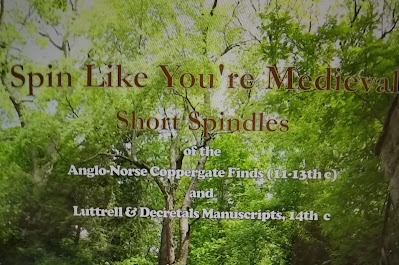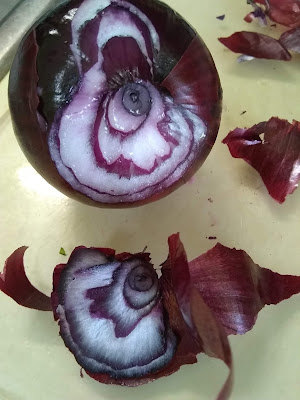A local friend I exchange emails with quite a bit, was asking about the spindle and how it relates to the spinning wheel, and it reminded me that I was going to write about that, because a lot of people to whom the whole notion of spinning is a bit of a mystery, often ask about it. This is all your doing, Marilyn!
The spindle far precedes the wheel in history. It's been found in prehistoric gravesites of women, the assumption apparently being that in the afterlife they would go right on spinning, so they'd better have their spindle at the ready. Well, to be exact, the whorl, which might have been stone or ceramic. The wooden shafts long since deteriorated to where they can't be found now.
For many centuries women spun linen, cotton and wool for all the fabric needs of their lives. Viking women spun the linen thread which was woven into sails for the ships which then proceeded to set off across the ocean to plunder my homeland, well, okay, it was a long time ago, and they did leave us with some wonderful northern language, still in use in the northern counties of the UK. And every stitch they wore was spun by women using the spindle. Then it was knitted or woven or used in other similar ways to clothe their entire families.
The distaff is that stick with a lollipop of yarn tied at the top that you see in old illustrations, always used by women, hence the term distaff side, meaning the wife's side of the family. It was a handy way of keeping a good supply of fiber available all the time she was out and about tending animals and poultry and gardens, and whatever else she had to do that day.
It wasn't originally about sitting peacefully in a little cottage with a view of mountains and spinning and humming contentedly. A spinner is known as a spinster, and the term meaning unmarried woman came about because if a woman didn't marry, spinning was her main means of self support and to take her place in the income of her family of origin. It was inescapable for her.
Anyway, much later, when greater production was needed, and there are a lot of academic debates and when and where, the wheel came into existence. Some people claim it predates the current era, some say it was medieval, some say European, some say rubbish, it was Arabic in origin (like a lot of other great ideas, such as algebra, look at the name if you doubt this!)
The wheel doesn't materially affected the actual drafting and spinning, but it saves a lot of time since the output is automatically fed onto bobbins, and you don't have to keep stopping to wind the yarn onto the spindle, as you do without a wheel.
So when faster was needed, the wheel, still operated by women, came into use. But now she couldn't wander about working as before. She was pretty much stuck where the wheel was. A precursor of the office job, in a way. And definitely a precursor of the Industrial Revolution, where the spinning wheel was mechanized and turned into a mass production machine, with which humans were obliged to work long, dangerous, poorly paid hours, don't get me started.
Anyway, I found the wheel, on my summer of trying it out, to be a rotten experience, like a treadmill, really. No stopping places except when a problem arose, just on and on. Now some people absolutely love this, and I'm not saying anything about that, just it's different strokes, different folks.
The spindle suits me, and a lot of other people, better, because it's two different activities, alternating, the spinning and the winding on. They're different skills, and I like the rhythm of moving back and forward between them. I also love the portability of the spindle, and I've spun in various rooms of the house. Not out of doors, because I don't want to be catching debris and leaves in my yarn, got enough to deal with. Some really skilled people spin while walking out of doors.
I don't spin in public, because nowadays it's unusual enough that people assume I'm demonstrating and want to stop me and ask questions, and that's not the deal. I have done public demos, which were advertised as such and I was glad to explain and stop and start for that purpose. But when I'm just quietly spinning, that's what I'm doing.
A word to the wise: if you see an artist working, and want to learn from them, assume you're requesting a professional lesson and that there will be a fee. Don't assume their skills are yours for the taking, okay? thank you. What I show here is what I want to share, and I'm glad to. But when I'm working, I'm working, and that's a different thing. I do refer people to YouTube a lot to get started on any interest, really, including the fiberarts. And when I go to my knitting groups, I'm there to play, just like everyone else, not to work, and teaching is definitely work, if you do it right. End of grouchy aside.
Anyway, that question about the history of spindles and wheels reminded me of lovely Lois Swales, a historian and researcher into textiles, who put up a highly entertaining series of short videos on YouTube a few years ago, which still work a treat. She dresses the part, too, always a nice touch!
So here's the result, two smaller spindles in the picture for comparison. And a nicely plied length of yarn waiting for additions, part of which is on the new spindle on the right.
A well spent morning, and if it encourages you to try your hand, good. If you just want to be entertained by Lois, good, too, she's very knowledgeable but also funny, a great combo, I'd say. She explains that she's a good teacher because she's made all the mistakes so she knows what she refers to as spinning tragedies!
If you're interested in research, be aware that the internet is packed with misinformation on the fiber arts often written by people who literally don't know that spinning is one thing and weaving another. Or that it's impossible for the princess to have been pricked by a spindle or any other part of a spinning wheel, which shows how reliable fairytale writers were, too! Stick with people like Lois and her references. You'll do better.


















































